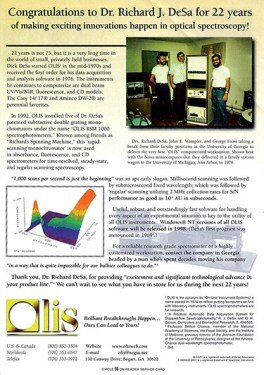Things about Uv/vis
Things about Uv/vis
Blog Article
The 10-Minute Rule for Spectrophotometers
Table of Contents10 Simple Techniques For Uv/vis/nirNot known Factual Statements About Uv/vis/nir Some Known Details About Circularly Polarized Luminescence The 25-Second Trick For Circular DichroismUv/vis/nir Can Be Fun For Everyone

Spectrophotometry is a tool that hinges on the quantitative analysis of molecules depending on how much light is taken in by colored substances.
The smart Trick of Uv/vis That Nobody is Discussing
A spectrophotometer is frequently utilized for the measurement of transmittance or reflectance of services, transparent or nontransparent solids, such as refined glass, or gases. Many biochemicals are colored, as in, they soak up noticeable light and therefore can be measured by colorimetric procedures, even colorless biochemicals can frequently be converted to colored substances appropriate for chromogenic color-forming reactions to yield compounds appropriate for colorimetric analysis.: 65 Nevertheless, they can also be created to measure the diffusivity on any of the noted light ranges that usually cover around 2002500 nm using different controls and calibrations.
An example of an experiment in which spectrophotometry is used is the decision of the stability constant of an option. A particular chemical reaction within an option might occur in a forward and reverse instructions, where reactants form items and items break down into reactants. Eventually, this chemical reaction will reach a point of balance called a stability point.
Some Known Facts About Uv/vis.
The amount of light that travels through the solution is a sign of the concentration of particular chemicals that do not permit light to travel through. The absorption of light is because of the interaction of light with the electronic and vibrational modes of molecules. Each type of molecule has a specific set of energy levels connected with the makeup of its chemical bonds and nuclei and thus will soak up light of specific wavelengths, or energies, resulting in unique spectral homes.
They are extensively utilized in lots of markets including semiconductors, laser and optical production, printing and forensic assessment, as well as in laboratories for the research study of chemical compounds. Spectrophotometry is often used in measurements of enzyme activities, determinations of protein concentrations, decisions of enzymatic kinetic constants, and measurements of ligand binding reactions.: 65 Ultimately, a spectrophotometer is able to determine, depending on the control or calibration, what compounds are present in a target and precisely how much through computations of observed wavelengths.
This would come as an option to the previously created spectrophotometers which were not able to absorb the ultraviolet correctly.
All about Uv/vis/nir
It would be found that this did not provide satisfactory outcomes, therefore in Design B, there was a shift from a glass to a quartz prism which enabled much better absorbance results - UV/Vis (https://pxhere.com/en/photographer/4182440). From there, Design C was born with a change to the wavelength resolution which ended up having 3 systems of it produced
It was produced from 1941 to 1976 where the rate for it in 1941 was US$723 (far-UV accessories were an option at additional cost). In the words of Nobel chemistry laureate Bruce Merrifield, it was "probably the most crucial instrument ever established towards the advancement of bioscience." Once it became stopped in 1976, Hewlett-Packard developed the very first commercially available diode-array spectrophotometer in 1979 understood as the HP 8450A. It irradiates the sample with polychromatic light which the sample soaks up depending on its homes. Then it is transferred back by grating the photodiode variety which detects the wavelength region of the spectrum. Since then, the development and implementation of spectrophotometry devices has actually increased tremendously and has ended up being one of the most innovative instruments of our time.

Uv/vis/nir Can Be Fun For Anyone
Historically, spectrophotometers use a monochromator containing a diffraction grating to produce the analytical spectrum. The grating can either be movable or repaired. If a single detector, such as a photomultiplier tube or photodiode is utilized, the grating can be scanned stepwise (scanning spectrophotometer) so that the detector can measure the light strength at each wavelength (which will represent each "action").
In such systems, the grating is fixed and the strength of each wavelength of light is determined by a different detector in the selection. In addition, most modern-day mid-infrared spectrophotometers utilize a Fourier transform technique to get the spectral details - http://www.cartapacio.edu.ar/ojs/index.php/iyd/comment/view/1414/0/30215. This technique is called Fourier change infrared spectroscopy. When making transmission measurements, the spectrophotometer quantitatively compares the fraction of light that goes through a referral service and a test option, then electronically compares the strengths of the 2 signals and calculates the percentage of transmission of the sample compared to the referral standard.

Report this page